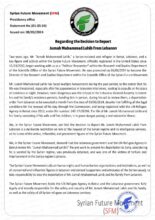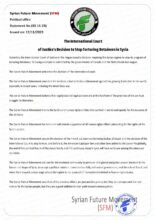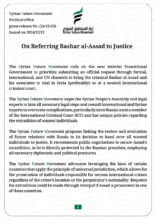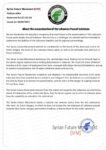About the Early Recovery Fund in Damascus!

The “We Are All Partners” website published on Facebook a translated news that the United Nations will establish a significant fund for early recovery projects in Damascus. It is worth mentioning that we did not find this news on their official channels, where the site mentioned the approval of the document (Early Recovery Strategy 2024 – 2028), which calls for the creation of an Early Recovery Trust Fund (ERTF). This new fund will be based in Damascus and will operate under the direct leadership of the UN Resident Coordinator for Humanitarian Affairs.
According to the United Nations Development Programme (UNDP) on its website, the term “early recovery” or “early rehabilitation” is an approach to address recovery needs that emerge during the humanitarian response phase of any emergency, using humanitarian mechanisms that align with development principles.
The difference between early recovery and reconstruction is highlighted through three distinctions according to a study by the Policy and Operations Research Center in an article titled “Early Recovery and Reconstruction in Syria between Reality and Policy”:
- The planning and implementation of reconstruction fall upon the state, while early recovery is planned and implemented by relief organizations, whether centralized under a single administrative body such as the United Nations, or individual organizations.
- Early recovery is a form of humanitarian aid, while reconstruction is not necessarily so; reconstruction can come in the form of concessional loans from individual or multilateral organizations like the International Monetary Fund or the World Bank, whereas early recovery is a type of humanitarian assistance that does not require repayment later.
- Early recovery priorities are arranged according to humanitarian needs, just like other forms of humanitarian aid, whereas reconstruction is not necessarily so.
Based on the news that seems pivotal in the Syrian scene, we attempt to read it from two perspectives (positives and negatives) to share our vision with those interested in the Syrian reality and to broaden the perspective for decision-makers.
Positives of the Early Recovery Fund in Damascus:
The Syrian people in all regions live in dire conditions, where the head of the UN Committee “Paulo Pinheiro” stated during an interactive dialogue with the Independent International Commission of Inquiry on Syria, at the 55th session of the Human Rights Council held in Geneva, that Syria is “more dangerous to live in,” emphasizing the unsafe return of Syrian refugees to their country due to violations by the Syrian regime, Turkish attacks in eastern Syria, and torture by the National Army in northern Syria, with the lack of a political settlement making the situation in Syria more complicated.
Nearly 90% of Syrians live in extreme poverty, while 60% suffer from food insecurity after severe drought—the worst in decades—exacerbated the risk of a comprehensive humanitarian disaster.
Thus, it can be said initially that any movement through the United Nations that contributes to alleviating the suffering of the Syrian people is a positive step. The UN’s movements towards early recovery have four positive aspects:
First: Restoring basic services such as healthcare, rehabilitating local schools, renewing mills, and protecting cultural heritage sites, similar to the Gaza experience in 2015 with the “Support for Education, Health, and Gender in the Transition from Emergency to Development,” funded by the German Federal Ministry for Economic Cooperation and Development (BMZ). All these are phases that are supposed to transition the country from conflict to peace and stability and help prepare the ground for subsequent reconstruction.
Second: Enhancing cooperation with non-governmental organizations, as the exceptions granted to these organizations facilitate direct aid delivery to the Syrian people.
Third: Undermining the Syrian regime’s pretext that economic sanctions affect the people, not its security and economic policies, the deterioration of transparency, and the spread of corruption in its governmental structure.
Fourth: Undertaking projects that provide much-needed relief to Syrian civilians in the medium and long term, benefiting from humanitarian work to seize developmental opportunities, develop resilience, and establish a sustainable recovery process. According to the program, early recovery simultaneously offers two things: an approach to humanitarian response that focuses through enhanced coordination on strengthening adaptability, rehabilitation, and capacity building, and contributing to solving chronic problems that exacerbated the crisis, rather than increasing it. On the other hand, it is a package of programmed actions defined to help people transition from dependence on humanitarian aid to development.
Negatives of Having a Recovery Fund in Damascus:
Due to the ongoing conflict and the Syrian regime’s stubborn refusal to accept any initiative or comprehensive political solution, establishing a fund in Damascus would create a situation of illusory success whose benefits would not be sustainable. Moreover, there are significant drawbacks, including:
- The Syrian regime’s exploitation of humanitarian aid in its negotiations with the international community, similar to its negotiations regarding the Bab al-Hawa crossing, where the regime’s agreement to allow UN aid through the border crossing with Turkey, without a Security Council resolution, was precisely what the Syrian Foreign Minister, Faisal Mekdad, requested during an Arab ministerial contact group meeting held in Cairo in August last year. This is about supporting Damascus to secure “early recovery” projects within the aid provided by the United Nations, where the regime and its allies exploited the renewal of the UN aid extension mechanism to Syria, insisting on including the “early recovery” issue in Security Council Resolution 2642, issued on July 9, 2021.
- The Syrian regime is skilled in nitpicking and overwhelming with details, allowing it, upon the establishment of the fund, to circumvent the economic sanctions imposed on it by relying on the funds and projects associated with “early recovery,” which have international cover through a Security Council resolution. Therefore, it is eager for the UN to increase these projects and expand them to include all sectors, especially the electricity sector, which is in a dire situation affecting all other sectors, including industry, agriculture, and tourism. Moreover, reconstruction projects are typically funded through repayable loans, while early recovery projects are offered as humanitarian aid, which is precisely what the Assad regime aims for.
According to a report by the Center for Strategic and International Studies, humanitarian aid has become the primary source of foreign currency for the Syrian regime, with the report indicating that Western donor governments have committed to providing $2.5 billion annually in aid since 2014 to help those in need and affected by the war in Syria. However, this aid primarily supported the Syrian regime, as it manipulated the exchange rate to receive a portion of these funds.
For example, in 2020, the Syrian regime obtained approximately 51 cents for every dollar transferred to Syria, forcing UN agencies to use an exchange rate lower than the market rate. - Marginalization of areas outside the regime’s control, which account for nearly half of Syria’s territory, such as the theft of earthquake aid by regime militias. In eastern Syria, UN engagement is limited to the Qamishli office, which reports to Damascus, and projects are implemented through local or international partners. Meanwhile, there is a lack of aid, organization, and expertise.
After the control of “Hay’at Tahrir al-Sham” over Idlib province, most “early recovery” projects were withdrawn after 2018, leaving only “emergency response” projects. Especially since Hay’at Tahrir al-Sham has unofficially decided to prevent aid from entering through regime-controlled areas to prevent it from being exploited for propaganda purposes. - Ignoring the implementation of the Geneva resolutions, especially Resolution 2254, which calls for the formation of a fully empowered transitional governing body, to focus international attention solely on early recovery issues, making it a long-term alternative to achieving a comprehensive settlement.
- Syria needs real reconstruction due to the extensive destruction, not just rehabilitation, and reconstruction cannot proceed without a sustainable political solution. Thus, the early recovery fund in Damascus would provide oxygen to the Syrian regime, easing economic pressure on it and enabling it to continue obstructing the political solution.
- The Emergency Response Fund’s communication with the Syrian regime is unclear, as the Early Recovery Strategy 2024-2028 refers to cooperation with municipalities; which will be discussed by the Supreme Relief Committee, as known in Assad’s Syria, chaired by the Ministry of Local Administration and Environment and the Ministry of Social Affairs and Labor, both of which are targeted by EU sanctions, including Asma al-Assad. However, some UN officials have mentioned that the sanctions do not cover early recovery efforts, suggesting a reality where support for the regime is renewed through the UN and sanctions on it are lifted.
- Lending political legitimacy to Assad’s regime by coordinating and cooperating with the Syrian regime in a way that legitimizes it.
Conclusion and Recommendation:
There is no doubt that early recovery can benefit the Syrian people if conducted transparently and thoughtfully, monitored first by Syrians and then by the international community, to prevent violations by the Syrian regime or any de facto authority over this project. In a study by the Omran Center, early recovery projects increased in the first half of 2022 compared to the second half of 2021 by 188 projects, with a 9% annual increase, and the financing sector receiving the most projects for the first time. Fifty-four percent of the projects were implemented in rural Aleppo, and 1,148 job opportunities were created by organizations and local councils in various economic sectors.
To ensure the effectiveness of the early recovery project in Syria, the Syrian Future Movement recommends implementing several factors:
- Repair and restoration of vital civil infrastructure, including basic infrastructure such as roads, bridges, schools, hospitals, and other public facilities.
- Removal of rubble and solid waste by cleaning the areas affected by debris and solid waste to improve living conditions.
- Focus and orientation towards income-generating activities and market-based intervention measures, by providing job opportunities and enhancing local economic activities.
- Vocational training and skills training by providing training and education to enhance individuals’ skills and improve employment opportunities.
- Social cohesion and community intervention measures, which include promoting cooperation and understanding among different community groups.
- Monitoring and preventing any authoritarian exploitation by the Syrian regime or any de facto authority in Syria of the early recovery projects.
- Ensuring that early recovery projects encompass the entire Syrian map equally among all regions.
It’s worth noting that these factors require cooperation and coordination among various parties, including the Syrian regime, the de facto authorities in areas outside its control, and local communities. This means obtaining guarantees from the allies of those authorities that the early recovery fund will not be exploited for the regime’s political benefit or to circumvent the lifting of sanctions on it.
Jomaa Mohamad Laheep
Political Office
Research and Studies Department
Studies
Syrian Future Movement (SFM)
References:
- Paulo Pinheiro: Syria has become more dangerous to live in and is not safe for the return of refugees (syria.tv)
- Early recovery and reconstruction in Syria between reality and politics – OPC
- Economic Recovery in Syria: A Map of Actors and an Evaluation of Current Policies – Pro Justice (pro-justice.org)
- The impact of early recovery and reconstruction projects on housing, land, and property rights in Syria – The Day After (tda-sy.org)
- Early recovery through assistance in health, education, and gender | UNRWA (unrwa.org)
- Guidance Note on Inter-Cluster Early Recovery | INEE
- “Early recovery”… an opportunity for the Syrian regime to seize reconstruction projects (alaraby.co.uk)
- Will the Syrian regime succeed in seizing “early recovery” projects? (alaraby.co.uk)
- How is the military control map distributed in Syria? | News | Al Jazeera (aljazeera.net)
- “The regime will exploit the situation”… There are those who prevent aid to northern Syria (alarabiya.net)
- After the earthquake.. What is the fate of humanitarian aid in Syria? And will the regime’s arms monopolize it? | News | Al Jazeera (aljazeera.net)
- How does humanitarian aid enter northern Syria? | News | Al Jazeera (aljazeera.net)
- “The eye on the palace”… Asma al-Assad and her “secret office” under the sword of sanctions – Economist (economist-sy.com)
- “Early economic recovery” projects between the exploitation of the regime and the benefit of Syrians (syria.tv)
- Omran Center for Strategic Studies – Early Economic Recovery in Opposition Areas during the First Half of 2022 (omrandirasat.org)






